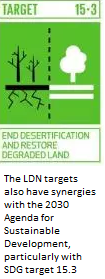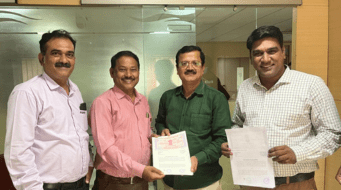By Arjuna Srinidhi* I New Delhi, June 17, 2019
On the occasion of World Day to Combat Desertification (WDCD 2019), India elaborated on its plans for managing its natural resources, undertaking sustainable land management and combating droughts. The highlighted actions are expected to help India meets its overall target of achieving Land Degradation Neutrality by 2030.
The overall target of achieving Land Degradation Neutrality by 2030 in envisaged through the national target of interventions in about 21 million ha of degraded land (including degraded wasteland, forest and agricultural land). This target would be achieved through a slew of technical and policy interventions that would target improving productivity, rehabilitate degraded common property resources and halt land-use conversion and restrict encroachments [1].
Minister of Environment, Forest & Climate Change, Prakash Javadekar also launched a flagship project on forest landscape restoration as part of the Bonn Challenge – a global effort to restore degraded lands [2]. India announced that it would introduce a pilot phase of 3.5 years implemented in the states of Haryana, Madhya Pradesh, Maharashtra, Nagaland, and Karnataka, and eventually scaled up across the country through subsequent phases of the project.

Mr. Javadekar also highlighted current government programs helping combat land degradation like wide use of soil health cards, promoting organic farming practices, focusing on water use efficiency, income support scheme, etc. The event also served as a curtain-raiser to the upcoming 14th session of the Conference of Parties (COP – 14) from 29th August – 14th September 2019 [3].
The urgency to act
According to the State of India’s Environment report (2017) [4], nearly 30 per cent of India is degraded or facing desertification. In eight states—Rajasthan, Delhi, Goa, Maharashtra, Jharkhand, Nagaland, Tripura and Himachal Pradesh—around 40 to 70 percent of the land has undergone desertification. A 2018 report on the Economics of Desertification, Land Degradation and Drought (EDLDD) found that it costs India nearly 2.54% of its GDP [5].

As the Union Minister Prakash Javadekar highlighted, India has around 17% of the global population, but only 2.5% of land and receives only about 1% of global rainfall, thus making it critical for the country to use its natural resources efficiently. In terms of the proportion of its responsibility, India’s 21 million ha constitutes 6% of global LDN target, which is more than double its 2.5% share of global land resources.
Globally, the issues of land degradation and water scarcity add to up to some startling figures. According to the UN, by 2025, two-thirds of the world will be living under “water-stressed” conditions – when demand outstrips supply during certain periods. And about 1.8 billion people will experience absolute water scarcity, where a region’s natural water resources are inadequate to supply the demand [6]. In his address on the eve of the World Day, the Executive of the UN Convention to Combat Desertification (UNCCD), Secretary Ibrahim Thiaw highlighted, “If we take action to restore our degraded land, it will save $1.3 billion a day to invest in the education, equality and clean energy that can reduce poverty, conflict and environmental migration”.
WOTR’s role in shaping land degradation efforts in India
Since its inception in 1993, the Watershed Organisation Trust (WOTR) has been at the forefront of mobilizing vulnerable communities in semi-arid and resource fragile regions to help them with regenerating the ecosystems and harvesting rainwater across the landscapes people live in. To date, WOTR has supported/ worked in 2,922 villages and has impacted 2.8 million people across 8 states in the country.
The recent annual report of the organization elaborates on the interventions related to Sustainable Land Management as well as establishes to international conventions like the UNCCD, the Paris Agreement on Climate Change and the 2030 Agenda for Sustainable Development [7]. WOTR was the recipient of the prestigious UNCCD “Land for Life Award” in 2017 for its pioneering work in combating desertification [8].
WOTR has been accredited as a civil society knowledge partner by the UNCCD and engages frequently at the national level with the focal point at Ministry of Environment, Forest and Climate Change, Govt. of India as well as international forums like the UNCCD Conference of Parties (COP) with technical as well as policy advocacy inputs. For instance, its pioneering work in participatory and inter-disciplinary approaches to combating desertification and land degradation was highlighted in the 2018 publication ‘A Better World’, by Tudor Rose in association with the UNCCD [9].
In the recent Pre-budget consultation on Agriculture held by the Hon. Finance Minister on 11th June 2019, WOTR made a number of critical suggestions related to combatting drought and land degradation. The inputs made by Crispino Lobo, co-founder and managing trustee (WOTR), included prioritizing soil health, integrated watershed development along hydrological lines, incentives to convert wet waste to safe organic manures, budgetary allocations to support bio-fertilizer production, etc. The complete Memorandum and recommendations are available on WOTR’s website[10].
WOTR is also engaged in soil protection and rehabilitation work under the ProSoil project with support from the Government of Germany and the National Bank for Agriculture and Rural Development (NABARD)[11]. While this project assists in strong community-level engagement and providing evidence-based inputs for replication and scaling, other upcoming projects focusing on Ecosystems-based adaptation and studies looking into the Economics of Land Degradation will provide very useful insights for policy advocacy at state and national level arising out of WOTR’s experiences.

*The author is a senior researcher in climate change and sustainable development policies with the WOTR Centre for Resilience Studies (W-CReS) based in Pune, India.
References
[1] http://pib.nic.in/PressReleseDetail.aspx?PRID=1574780
[2] http://www.bonnchallenge.org/content/challenge
[3] https://www.unccd.int/conventionconference-parties-cop/unccd-cop14-new-delhi-india
[4] https://www.downtoearth.org.in/reviews/state-of-india-s-environment-2017-in-figures-ebook–57874
[6] https://news.un.org/en/story/2019/06/1040561
[7] https://wotr.org/sites/default/files/Annual_Reports/Annual%20Report%202017-2018.pdf
[8] https://wotr.org/wotr-wins-un-2017-land-life-award
[9] https://wotr.org/system/files/articles/A_Better_World.pdf
[10] https://wotr.org/sites/default/files/Pre_Budget_Memorandum.pdf





